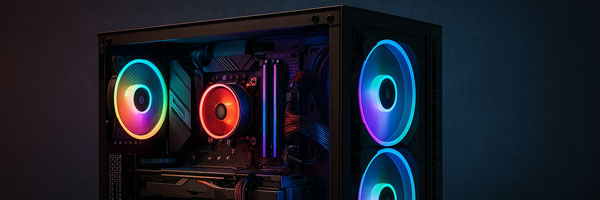Enhance the performance of your gaming PC for streaming
Optimize Your Gaming PC for Streaming: A Complete Guide
In the age of live content creation, streaming has become more than just a hobby—it’s a profession, a community, and a powerful platform for gamers. Whether you’re broadcasting on Twitch, YouTube, or Facebook Gaming, optimizing your gaming PC for streaming is essential for delivering a smooth, high-quality viewing experience while maintaining top-tier in-game performance.
This comprehensive guide will walk you through everything you need to know to ensure your gaming PC is streaming-ready—from hardware upgrades to software tweaks and streaming software setup.
1. Hardware Optimization
The foundation of any solid streaming setup is capable hardware. Streaming and gaming are both resource-intensive, and running them simultaneously demands balanced performance from your CPU, GPU, RAM, and storage.
CPU (Central Processing Unit): A multi-core processor is vital. Modern streaming encoders (like x264 and NVENC) rely heavily on CPU power if you’re using software encoding.
Recommended:
- AMD Ryzen 7 / Ryzen 9
- Intel Core i7 / i9 (10th Gen or newer)
GPU (Graphics Processing Unit): While games depend heavily on GPU power, many streamers now take advantage of GPU encoding (like NVIDIA’s NVENC), which offloads some of the CPU’s tasks.
Recommended:
- NVIDIA GeForce RTX 3060 and above
- AMD Radeon RX 6700 XT and above (less common for streaming but improving)
RAM (Memory): At least 16GB of RAM is recommended for gaming and streaming simultaneously.
Tip: Dual-channel setups provide better performance than single-channel.
Storage: Use an SSD (Solid State Drive) for both your operating system and games. This ensures fast load times and reduces lag spikes during streaming.
2. Internet Connection Stability
Your internet upload speed is crucial for streaming. A high-quality stream requires not only fast speeds but also stability.
Minimum Upload Speed Requirements:
- 720p @ 30fps: 3–4 Mbps
- 1080p @ 60fps: 6–8 Mbps
- 1440p or 4K: 10–20+ Mbps
Tips:
- Use a wired Ethernet connection over Wi-Fi
- Test your internet speed using reliable tools (like Speedtest.net)
- Consider upgrading your internet plan if you’re experiencing frequent buffering
3. Choosing the Right Streaming Software
There are several popular streaming platforms, with OBS Studio, Streamlabs OBS (SLOBS), and XSplit being the top choices.
OBS Studio: Free, open-source, and highly customizable. Widely used by professionals.
Streamlabs OBS: User-friendly interface and built-in features for donation alerts, overlays, and more.
XSplit: Powerful but requires a subscription for some premium features.
Tips for Setup:
- Configure your resolution and frame rate (720p or 1080p at 30 or 60 fps)
- Choose the correct encoder: x264 (CPU) or NVENC (GPU)
- Bitrate settings (adjust based on your upload speed)
- 720p: 2500–4000 Kbps
- 1080p: 4500–6000 Kbps
4. Optimize In-Game Settings
You don’t need ultra settings to impress viewers. Prioritize smooth performance.
Tips:
- Lower shadows, reflections, and anti-aliasing for performance gains
- Enable V-Sync or a frame limiter to avoid screen tearing
- Run games in Borderless Windowed mode for easy tab switching
Many games also offer performance-optimized presets; use these as a baseline and tweak as needed.
5. Tweak Windows and System Settings
Making small changes in your operating system can help free up resources.
Tips:
- Set Windows power plan to “High Performance”
- Disable unnecessary startup programs
- Keep your graphics drivers and Windows OS updated
- Disable Game DVR in Windows to save system resources
You can also use tools like CCleaner to remove junk files and registry errors.
6. Setup Dual PC Streaming (Advanced Option)
For those wanting the absolute best performance, consider a dual-PC setup where one PC handles gaming and the other handles streaming.
What You Need:
- Two PCs (one for gaming, one for streaming)
- A capture card (Elgato, AVerMedia, etc.)
- Audio interface or mixer to route sound
Benefits:
- No impact on game performance
- High-quality encoding and flexibility
This setup is ideal for competitive streamers and those who want maximum control.
7. Use Quality Overlays and Alerts Efficiently
Overlays enhance the visual appeal of your stream, but too many elements can overload your system and distract viewers.
Tips:
- Use lightweight overlay files (avoid large GIFs or high-res animations)
- Choose clean, simple layouts that highlight your content
- Integrate alerts for new followers, donations, and subs using Streamlabs or similar services
8. Monitor Your Stream Performance
Keep an eye on your stream’s quality while live to ensure everything runs smoothly.
Tools and Practices:
- Use OBS’s Stats dock to monitor dropped frames and encoding lag
- Keep your CPU/GPU usage below 85% during streaming
- Read chat or have a mod help you monitor feedback from viewers
You can also record test streams to fine-tune your settings without going live.
9. Maintain Your PC Regularly
A well-maintained PC will always perform better.
Maintenance Checklist:
- Clean dust from fans and heatsinks
- Replace thermal paste if temperatures are rising
- Defragment HDDs (not SSDs)
- Run antivirus and malware scans monthly
- Check for hardware updates (BIOS, firmware, drivers)
10. Additional Streaming Enhancements
Beyond your PC setup, there are other ways to upgrade your streaming quality:
Microphone: Use a dedicated mic like the Blue Yeti or Elgato Wave.
Camera: A quality webcam or DSLR with a capture card improves visual professionalism.
Lighting: Proper lighting (ring lights, key lights) makes a huge difference in camera quality.
Green Screen: Useful for background removal and creating a more immersive layout.
Final Thoughts
Optimizing your gaming PC for streaming is about balancing visual quality, system performance, and audience engagement. With the right hardware, fine-tuned settings, and regular maintenance, you can create a seamless streaming experience that keeps viewers coming back for more. Whether you’re just starting out or looking to refine your current setup, applying these strategies will ensure your stream looks sharp and runs smoothly.
As streaming evolves, stay informed about new technologies and tools to maintain a competitive edge. Happy streaming!

